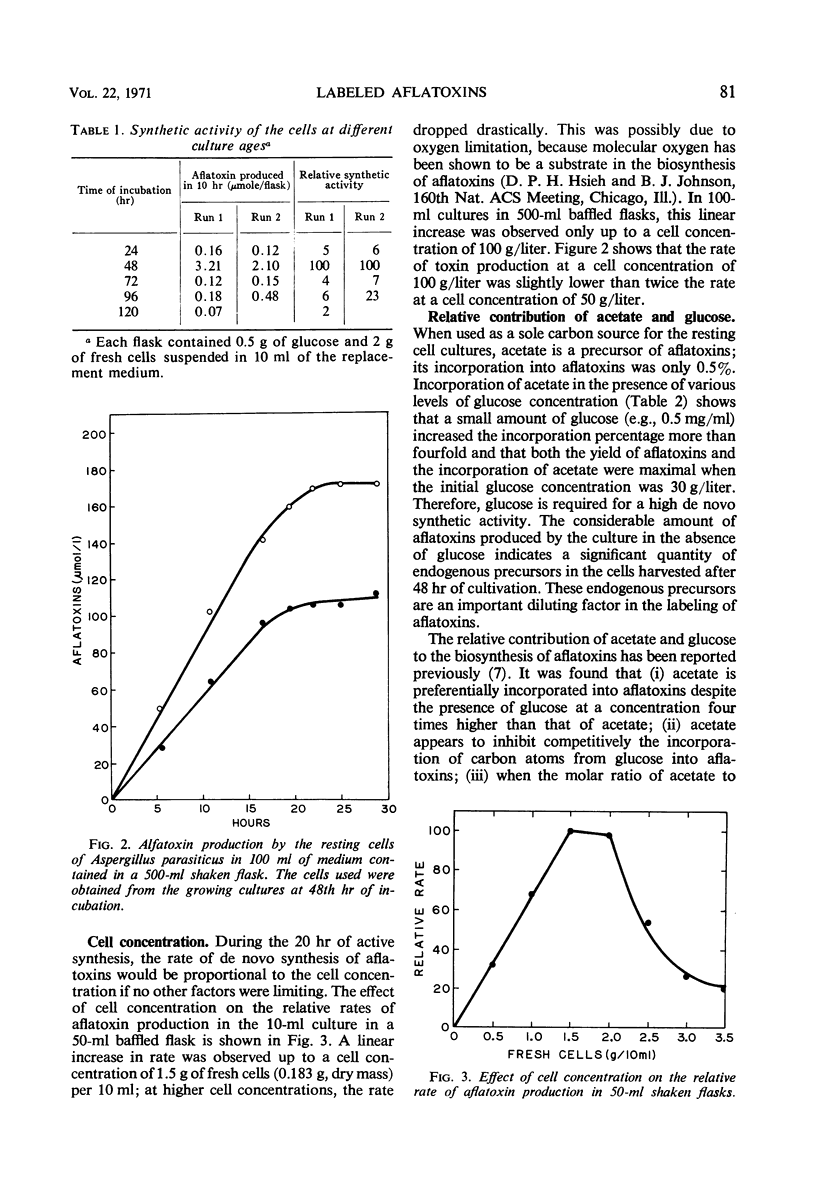Abstract
Resting cells of Aspergillus parasiticus ATCC 15517 were used to prepare highly labeled aflatoxins from labeled acetate. High synthetic activity in growing cells was evidenced only during 40 to 70 hr of incubation. Glucose was required for high incorporation efficiency, whereas the concentration of the labeled acetate determined the specific activity of the product. When labeled acetate was continuously added to maintain a concentration near but not exceeding 10 mm, in a culture containing 30 g of glucose per liter, 2% of its labels could be recovered in the purified aflatoxins which have a specific activity more than three times that of the labeled acetate.
Full text
PDF




Selected References
These references are in PubMed. This may not be the complete list of references from this article.
- ADYE J., MATELES R. I. INCORPORATION OF LABELLED COMPOUNDS INTO AFLATOXINS. Biochim Biophys Acta. 1964 May 11;86:418–420. doi: 10.1016/0304-4165(64)90077-7. [DOI] [PubMed] [Google Scholar]
- Biollaz M., Büchi G., Milne G. The biosynthesis of the aflatoxins. J Am Chem Soc. 1970 Feb 25;92(4):1035–1043. doi: 10.1021/ja00707a050. [DOI] [PubMed] [Google Scholar]
- CHANG S. B., ABDEL-KADER M. M., WICK E. L., WOGAN G. N. AFLATOXIN B2: CHEMICAL IDENTITY AND BIOLOGICAL ACTIVITY. Science. 1963 Nov 29;142(3596):1191–1192. doi: 10.1126/science.142.3596.1191. [DOI] [PubMed] [Google Scholar]
- Donkersloot J. A., Mateles R. I. Enrichment of auxotrophic mutants of Aspergillus flavus by tritium suicide. J Bacteriol. 1968 Nov;96(5):1551–1555. doi: 10.1128/jb.96.5.1551-1555.1968. [DOI] [PMC free article] [PubMed] [Google Scholar]
- Duncombe W. G. Fatty acid synthesis in rat adipose tissue. Tracer concentration effects in vitro. Biochem J. 1968 Jan;106(1):179–183. doi: 10.1042/bj1060179. [DOI] [PMC free article] [PubMed] [Google Scholar]
- Hsieh D. P., Mateles R. I. The relative contribution of acetate and glucose to aflatoxin biosynthesis. Biochim Biophys Acta. 1970 Jun;208(3):482–486. doi: 10.1016/0304-4165(70)90222-9. [DOI] [PubMed] [Google Scholar]
- MATELES R. I., ADYE J. C. PRODUCTION OF AFLATOXINS IN SUBMERGED CULTURE. Appl Microbiol. 1965 Mar;13:208–211. doi: 10.1128/am.13.2.208-211.1965. [DOI] [PMC free article] [PubMed] [Google Scholar]
- Wogan G. N., Edwards G. S., Shank R. C. Excretion and tissue distribution of radioactivity from aflatoxin B1-14-C in rats. Cancer Res. 1967 Oct;27(10):1729–1736. [PubMed] [Google Scholar]


